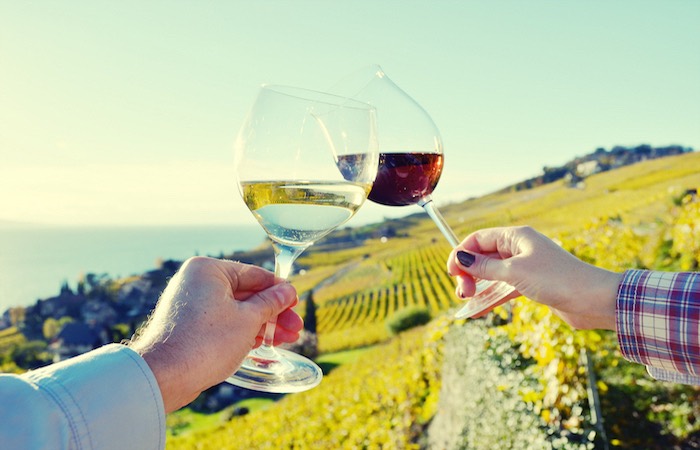All Wine, whether still,sparkling , fortified, or aromatized, is fermented grape juice. It may be red,white or pink (rose’) and dry, medium, or sweet in style, with an alcohol content of 5.5 to 14 percent. Grape spirit is added to fortified wine, raising the alcohol level to 15-22 percent. Sparkling wine contains trapped carbon dioxide (CO2) bubbles, which are released on opening.
HISTORY OF WINE
Archeological clues suggest that grapes were cultivated as far back as 4000 BC, and although theexact origins of wine-making are uncertain, cultivation has merely refined what is a natural process. Stronger glass and tighter stoppers, and louis. Pasteur’s research into fermentation in ther 19th century enabled the production of wine to develop into the huge commercial industry that is today.
WHICH GRAPE MAKE WINE ?
Vine make up a large,diverse plant family. All the classic wine making grapes come from species Vitis Vinifera, which yields the largest and sweetest fruits. Thousand of variety determines the character of any given wine, although growing conditions and the wine making process will affect the final result.
Type of Grapes :
a. Cabernet Sauvignon :
b. Chardonnay :
c. Chenin Blanc :
d. Gamay :
e. Gewurztraminer :
f. Grenache :
g. Merlot :
h. Pinot Noir :
i. Riesling :
j. Sauvignon Blanc :
k. Semillon :
l. Syprah (Shiraz) :
m. Zinfandel :
Other Important Grape Varieties :
- Barbera makes light, fruity Italian reds.
- Colombard makes fresh tangy white wines in France, California, and Australia.
- Muller-Thurgauis a mediocre relative of Reisling, used in cheap white German wine.
- Muscat covers several related white varieties,all with a distinctive musky aroma and grapey
- Flavour.It is grown throughout southern Europe.
- Nebbiolo(red) is used for Italian Barolo.
- Pinotblanc and pinot gris make whites in Italy, France, and Germany.
- Pinot blanc is similar to chardonnay, pinot gris is more aromatic.
- Sangiovese(red) is the main grape in chianti.
- Sylvaner, a prolific grape, makes dry white.
- Tempranillo(red) is the chief variety in Rioja.
- Viognier makes condrieu, an excellent quality dry white that is perfumed and full-bodied.
Where Wine is produced ?
- Mexico has potential, but its grape crop is almost all distilled or used as table grapes.
- England & Wales
- Yield are as erratic as the climate, but medium grapery whites and a better drier style are characteristic.
- Israel’ Best wines (some of them kosher) are produced by the cooler vineyards of the Golan Heights.
- Brazil’s wines tend to be exported, while most wine from Uruguay is consumed locally.
- Moldova
- Formerly part of the USSR, Moldova wine industry is showing renewed potential.
- Turkey
- Despite extremely large areas under vine, not much wine is made in thiscountry where Islam dominates-a religion that prohibits alcohol.
- Japan
- Wine produced here is often a blend oflocal and imported grapes.
- China produces grape wine, but rice wine has long been more popular. This is changing with outside influence.
- India makes some decent sparkling wines using the champagne method.
- Zimbabwe
HOW WINE IS MADE :
Harvesting Grapes :
When to pick the grape isan agonizing decision for growers. As grape ripen their acid levels reduce,while sugar, colour, and tannins increase. A whine need for acidity must be balanced with the desire for richness gained from ripeness.
Making White Wine :
White wine is made from white grapes, although black grapes can be used if they are not crushed and are pressed immediately.
Grape must be transported with care from vineyard to winery as soon as possible after harvesting to ensure they arrive in peak condition.
Before Grape are lightly crushed to release the juice and bring it into contact with yeasts on the grape skins, stalks and pipes are removed.
The crushed grapes may be pumped into a tank called a Vinimatic to be macerated – steeped with their skins – for 12 to 48 hours to extract flavours and aromas stored in the skins.
Only juice that runs off and that from the first pressing is fresh and fruity enough to be used for making white wine. This juice is allowed to fall bright and may be filtered.
Fermentation takes place in either stainless – steel vats or in oak casks. Most white wines are filtered and bottled straight away to preserve their freshness.
Making Red Wine :
The process of making red wine is similar to that of making of white. Its special feature is that the grape skins are in contact with the fermenting juice, giving much greater depth of flavor and colour.Fermentation, lasting from 10 to 30 days, is at a higher temperature than for whites.
Red wine is almost always made from black grapes. Much of its character comes from tannins. These chemicals play key role in ageing red wine.
The stems and stalks are usually taken off : the tannins they contain are often too harsh. Grapes are slightly crushed to get juice, thus allowing fermentation t begin as quickly as possible.
Both juice and skins are put in a fermentation vat, where conditions are subject to vary strict control. Grape solids give the juice colour.
After fermentation on skins, free – run wine is drained off and solids squeezed to release press–wine. A portion of this much more tannic liquid may be used at a later stage to balance the finished wine.
Some not very expensive wine is bottled straight away, but most is run into oak casks or stainless- steel vats to age.
WINE TASTING :
Do’s& Don’ts :
Formal Tasting should take place in a neutral well lit environment. Use your senses of sight, smell and taste in that order, to assess and evaluate a wine.
- Do clear your palate with water between wines.
- Do make notes of your impression of all wines.
- Don’t eat anything before or during a tasting.
- Dot wear scent, other aromas are intrusive.
Indian Wine Industry :
Indian wine industry is rapidly increasing and is expected to grow at an annual growth rate of 27 percent from 2010 – 2012. Indian wine industry has emerged has the fasted growing market globally.
With a population of 1.12billion, currently the consumption of wine is very low, indicating vast potential for future growth. Beside low consumption the new western culture is giving a new turn to the wine consumption in India. The Indian wine market is largely dominated by domestically produced wine such as by Grovers and Sulla.The sales of domestic wines will continue to dominate the Indian wine market over the coming years, but as the knowledge increases high growth will also be seen in the consumption of imported wine. The consumption of imported is increasing by around 30 per cent in the coming years.
The Indian wine industry /market is still not well grown. Currently we are manufacturing just over one million cases of wines in India and around 0.15 to 0.2 million cases of imported wines. The Indian wine market is total of 2 per cent of the total alcohol industry. A lot need to be done interms of education and awareness of wine in India.
Currently most of the wine imported in India are from France (40 percent); Itlay (15 per cent), Australia(12 percent). Other countries from wines are imported are Chile, USA, South Africa and New Zealand.
Indian Red Wine consumption is at 45 percent and white wine consumption is at 40 percent, 13percent is sparkling wine and 2 percent is for Rose wine.
Currently two big wine companies in India are Grover and Sula.
Sula Vineyard :
Sula wines are produced with grapes harvested from Nasik and Dindori estate vineyards as well as from local contract farmers operating under the expert guidance of the Sulateam. Sula’s philosophy reiterates thatgood wine can only come from good grapes, and grapes can only be good as theirterroir – the magical combination of geographical and climatic conditions –permits.
Sula vineyards are proud to present their new tasting room – India’s first, located right in their Nasikestate designed by Californian architects Andy Hope (of the stanford design school) and laurel roth, the 2000 sq. ft. tasting room boasts a blue mosaic balcony bar with a spectacular view of the vineyards and the surrounding lakes and hills. the 34 feet bar itself runs continuously from the inner room to the open balcony and is softly lit by wine bottle lamps hanging from the ceiling. More wine bottles glow alluringly from embedded backlit cases in the wood paneled wall, while a large window in the back offers a view directly into the winery’s operational bottling room. A large glass-sided display area showcasing sula t-shirts, corkscrews,stemware and ice-buckets for sale complete the charm of the tasting room. the tasting room is a great place around which to build a 1 or 2 day getaway. Knowledgeable wine-makers who are always on hand To answer questions about viticulture and wine-making process from grape to bottle. you will also see proper steps to see, swirl, swift and sip wine.
Grover Vineyard :
Oneof the famous Indian wine, Grover Wine binds the three generation grandfather,father and daughter. Located just 40 kms from Bangalore in the state ofKarmnataka, that just got its attention to rest of the world.
The region offers travelers tranquil surroundings, a rich history beautiful vistas and allows them to train their binoculars over the spectacular bird watching, Bulbus, Blue Capped Rock Thrush, Tawny Eagles, Puff-throated Babblers etc.
Groveris spread over 410 acres on the foothills of Nandi Hills. The company started with the Premium Indian wine industry and slowly transforming India’s reputation as a maker of exciting wines to a producer of world-class, award winning wines.
The vineyard are covered with lush grapes, covering every available space on the soil in the valley. It flourishes with Cabernet Sauvignon, Shiraz, Viognier and Sauvignon Blancgrapes.
The best wine by the company is La Reserva –La Réserve has a powerful bouquet of luscious ripe red and black fruits with anexquisite hint of spice. It combines grace and splendor on the palate with chocolate, coffee beans and vanilla flavors. The finish is long, ample andalmost magical. Today Grover follows the philosophy which is based on the belief that wine should bring out the most faithful expression of both its grape varietalas well as terrior.


Comment (0)